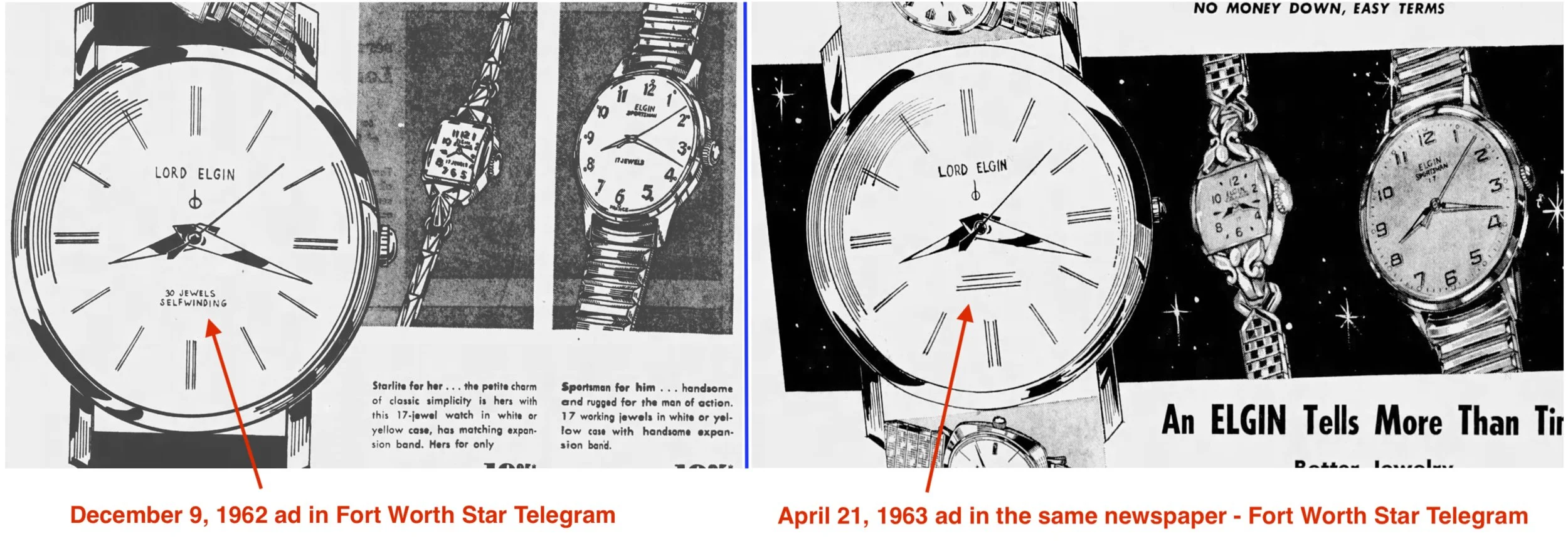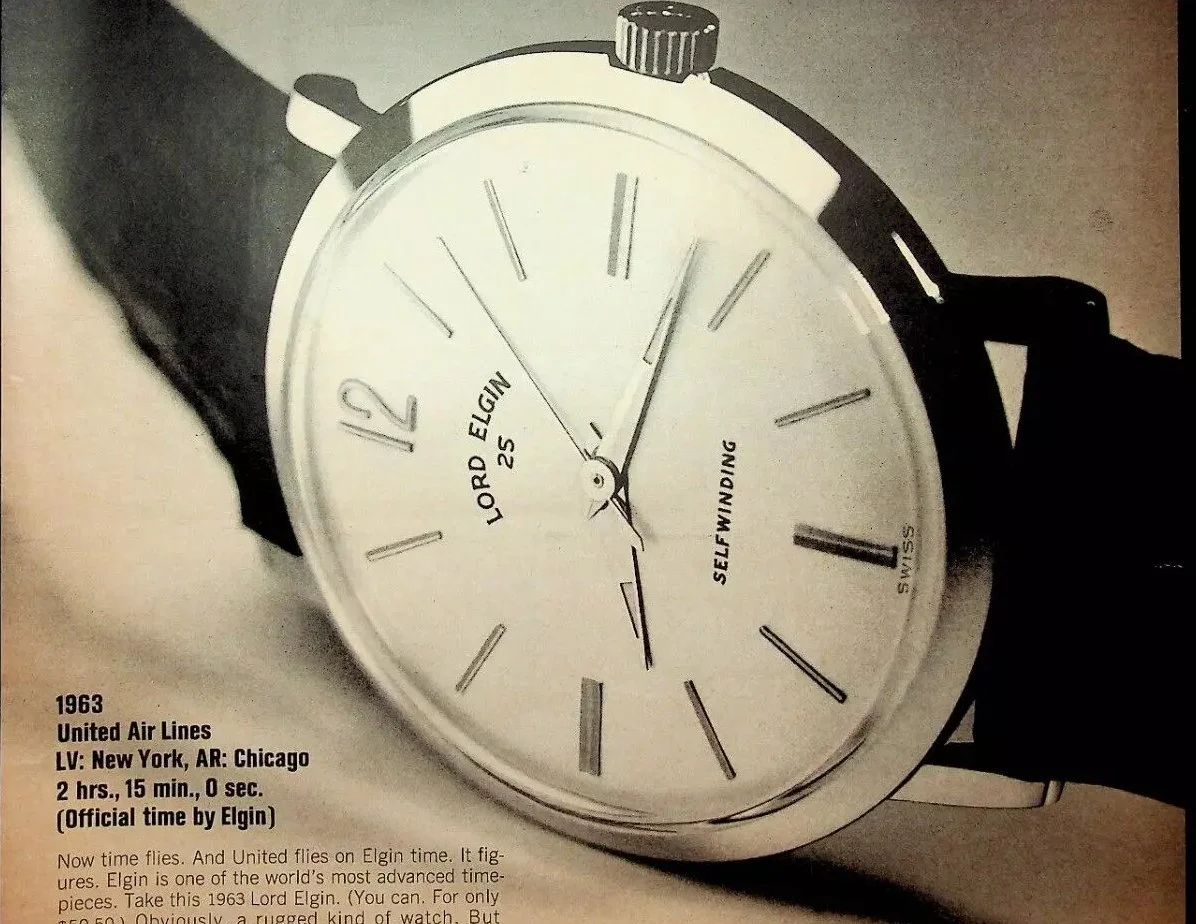
Development History of Elgin’s 27 and 30 Jewel Self-Winding (Automatic) Watches
When Were the 27 and 30 Jewel Elgin Automatics Made?
In its final years, Elgin launched a fabulous line of American-made 27 and 30 jewel automatic watches (jewels refers to tiny “working jewels” which increase the precision and durability of the gears in the watch’s timing mechanism; not for decoration). The base models cost a week’s wages for an average American worker, and the most expensive models cost more than a Rolex Oyster. [1] Due to the shutdown of Elgin’s main plant in 1964 and its disappearance as an independent company in 1968, many Elgin records were lost. There has been some uncertainty regarding the time period when these 27 and 30 jewel automatic watches were made. New research indicates the first complete watches began production in late 1958 and began to be sold in mid-1959; and the decision to end production likely occurred in late 1962, with the final “in process” watches being completed by mid-1963.
A. When did Elgin Start Making These Watches? Some important background facts:
— Back in 1950, Elgin launched the first American-made self-winding watch, the so-called 18 jewel “bumper automatic.” [1*] Although an excellent watch, the “bumper” winding technology was inefficient compared to “full rotor” automatics.
In 1952, after ending production of the bumper automatics, Elgin for the first time began selling watches with imported Swiss 17 jewel full rotor automatic movements. [2] This happened around the same time that President Truman rejected his own tariff commission’s recommendation that import duties be increased on Swiss watches. [2*] . For years, Elgin and other watchmakers had been pleading—unsuccessfully—with the U.S. government to increase tariffs to protect U.S. manufacturing.
— Truman’s successor, President Eisenhower, reversed course and imposed significant tariffs on Swiss watches in 1953. Eisenhower’s U.S. Department of Justice also filed a major federal antitrust lawsuit against the Swiss watch cartel in 1954. Elgin could have imported 27- and 30-jewel Swiss movements into the U.S.—as it did for watches sold in Canada. Probably due in part to Eisenhower’s decision, Elgin decided to make these watches entirely in America.
— Elgin’s 27- and 30-jewel automatics had the highest jewel count and were among the most complex watches Elgin ever made. Most of the parts were all-new; only “a few of the parts are interchangeable with prior grades.” [3] For example, out of 73 parts listed for the 30j movement, 53 of them are new and unique. The real number of unique parts is even higher because some “parts” (like the barrel) are actually made of multiple separate parts.
Developing these watches was a major project: Elgin needed to design and prototype the 27/30j movements and their components; build machine tools to make the new parts; work with vendors to develop/procure new cases, crystals, straps, bracelets, and packaging; manufacture the components; train staff on the new designs; and assemble, test, inspect, package, advertise, and ship these complex new watches.
Two examples of scale: Elgin worked with watchcase makers Star, Jonell, Ross, Queens, and I.D. to create an astonishing 59 different types of cases for these watches. Elgin also created an even larger number of dial designs for these watches. This was not an overnight project. It’s reasonable to infer Elgin’s 27- and 30j watch project took years, and may date back to Eisenhower’s tariff decision of 1953, or perhaps earlier.
Clear evidence shows the first “market ready” 30 jewel Elgin watches began to be assembled prior to November 1958. The first advertisement for this watch is dated May 1, 1959, and Elgin’s advertising says it takes 6 months to build the watch (plus time for shipping the watches from Elgin to the jeweler).
B. When did Elgin stop making these watches?
The best evidence indicates that Elgin decided to stop manufacturing these watches in late 1962, with the final “in process” watches being completed by mid-1963.
(1) Elgin’s 27/30j watches were only made at the historic 107 National Street plant in Elgin, which in mid-1962 became slated for shutdown.
In 1958, all of Elgin’s U.S. watch production was consolidated at the historic main plant in Elgin. [4] At the June 1962 shareholder meeting, management proposed to shut it down, and “no opposition to the planned abandonment of the Elgin plant was voiced.” [5]
Three months later, Elgin announced a new plant would be built in South Carolina. [6] However, the South Carolina plant only made women’s watches, which meant that after the historic main plant closed, Elgin would no longer make the 27/30j or any other men’s watches in the U.S. [7] While the old main plant was winding down operations until it finally closed in 1964 [8], other evidence appears to place the decision to end 27/30j production in late 1962:
(2) All known 27 and 30j models were launched between 1959 and 1962. All of the known models (A, B, C, etc.) for the 27/30j line were launched between 1959 and 1962. This indicates there was no real further development of the product line after 1962.
(3) Elgin’s “Factory Expert” newspaper ad campaign stopped featuring the 27/30j watches after 1962
Elgin ran large newspaper ads from late 1960 through 1964 to promote visits by salesmen who displayed Elgin’s entire (~ 500 watch) lineup at major department stores and jewelers. The newspaper ads showed images of various watches.
From late 1960 through 1962, 61% of the “Factory Expert” ads (31 out of 51) had images / descriptions of the 27/30j watches. After 1962, the “Factory Expert” ads never mentioned the 27/30j watches again:
The “erasure” of the 27/30j watches is starkly shown by comparing an ad that Elgin placed in the Fort Worth Star Telegram in December 9, 1962 with ad in the same paper on April 21, 1963. The December 1962 ad has an image of a Lord Elgin with “30 Jewels Selfwinding” written on the dial. Less than 5 months later, the April 1963 ad uses essentially the same image — but the words “30 Jewels Selfwinding” have been deleted and replaced with blank lines. [10]
(4) Elgin’s national ads stopped featuring the 27/30j watches after 1962 — and instead began advertising a Swiss-made 25 jewel automatic watch
Between 1959 and 1962, Elgin took out advertisements in Life and other national magazines featuring the 27/30j watches. These were often large color ads, like the one at the very top of this page. Elgin’s national ads stopped mentioning the 27/30j watches after 1962. In 1963, Elgin began advertising a new line of 25 jewel Swiss-made watches in national and local publications. [9] It is evident the Swiss 25j was intended to replace the American-made 27/30j watches. Remember the “Factory Expert” ads that stopped mentioning the 27/30j watches after 1962? In 1963, Elgin also began promoting the Swiss 25j watches in those ads. [11]
C. Is there any evidence that might suggest a different production period?
There are many ads from 1963-onwards by local jewelry stores offering Elgin 27/30j watches for sale. Some ads offer the watches at full price; others have them discounted. This does not mean Elgin was actively manufacturing these watches after 1962 (except watches “in process” which presumably were finished after the termination decision was made). In these ads, jewelers could be moving old inventory, or selling watches they purchased from Elgin’s remaining inventory after 1962. There is no reason to think Elgin (or jewelers) had sold out of their entire stock of 27/30j watches by the end of 1962.
A more interesting question involves watches Elgin made with dials indicating a later production date: the best example is watches for the January 1, 1964 Orange Bowl football game. The watches are marked “American Made” and use the normal 27 jewel Model “L” case nr. 4448 with a custom dial. These watches could have been made almost any time in 1963.
Doesn’t that mean Elgin was still actively manufacturing these watches after mid-1963? Not really. The watches could have been made in the first half of 1963, as Elgin was presumably wrapping up normal production. Even if they were made in the second half of 1963, it is unlikely Elgin would have continued or restarted full production for such a limited purpose. More likely, Elgin was just adding a new dial to remaining inventories of partially assembled 27/30j watches. At the time, Elgin also had spare parts that it could use to assemble watches, or sell as replacement parts. (Even today, some 27/30j parts can still be purchased as new old stock (NOS) in original Elgin packaging.) But that is not the kind of active manufacturing process that occurred earlier.
Conclusion: Research indicates the first 27/30j watches began to be built in late 1958 and were first offered for sale in mid-1959; and the decision to end production likely occurred in late 1962, with the last “in process” watches being finished by mid-1963.
——
Footnotes:
[1] On workers’ incomes, see https://www2.census.gov/prod2/popscan/p60-036.pdf . On Rolex pricing, see for example the ad in the Detroit Free Press on November 10, 1963, page 161, for Rolex “Steel and gold perpetual oyster Strap Watch, 25 jewels, $185”. The most expensive advertised 30 jewel Elgins were $195 and $200. See for example the ad in The Plain Dealer (Cleveland) on May 6, 1962.
[1*] https://vieren.co/stories/what-is-an-automatic-watch/#history ; see also https://www.reservoir-watch.com/services/glossary/bumper-movement-luxury-mechanical-watches-explained
[2] Elgin Time, p. 126
[2*] Elgin Time, pp. 121-122
[3] Elgin Service Manual, 1960 insert, 760 / 761 parts pages
[4] Elgin Time, p. 140
[5] Chicago Tribune, June 27, 1962, p. 52
[6] Belvidere Daily Republican, Sept. 5, 1962, p. 2
[7] The Charlotte Observer, March 11, 1963, p. 5
[8] https://www.chicagotribune.com/2016/10/03/clock-tower-for-elgin-watch-co-demolished-50-years-ago-2/
[9] Battle Creek Enquirer, April 28, 1963, p. 16 ; Daily News, April 17, 1963, p. 7 ; The Ashland Progress (AL), April 18, 1963
[10] Compare Fort Worth Star Telegram, Dec. 9, 1962, p. 68 with Fort Worth Star Telegram, April 21, 1963 p. 13
[11] The Ogden Standard Examiner, Dec. 5, 1963, p. 37 ; see also Fort Worth Star Telegram, April 21, 1963, p. 13




